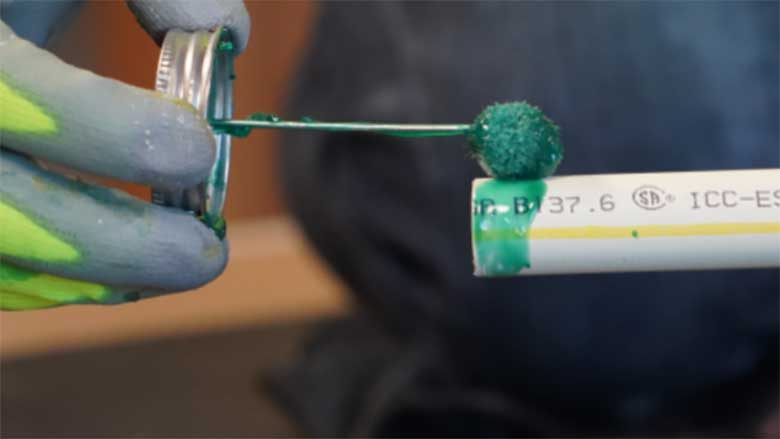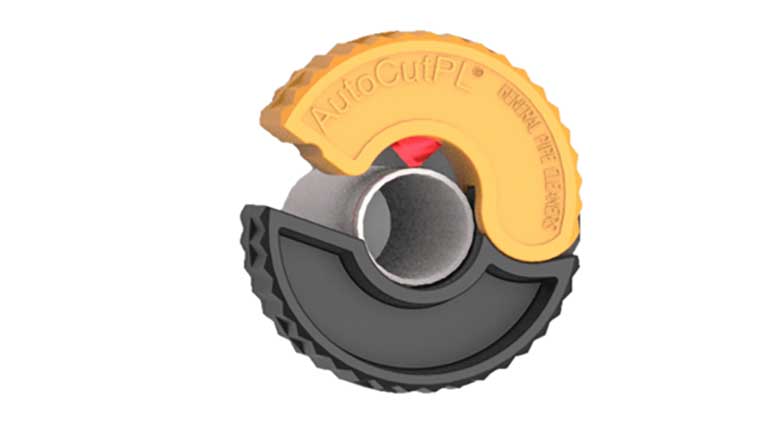Tips for installing and servicing CPVC pipes
Getting the most out of CPVC plumbing systems

Virtually every CPVC failure can be traced to either installation errors or exposure to incompatible chemicals. Photos courtesy of FlowGuard Gold
CPVC plumbing systems offer an inherent immunity from chlorinated drinking water. The chlorine molecules represented by the two “Cs” in CPVC create a protective barrier against the chlorine-based disinfectants used in U.S. water treatment processes. The unique chemistry of CPVC makes it the material immune to corrosion or degradation caused by chlorinated water.
As a result, virtually every CPVC failure can be traced to either installation errors or exposure to incompatible chemicals. Unlike chlorine degradation, these failures are largely controllable and can be minimized by taking some simple precautions.
Installing CPVC properly
CPVC is much like copper plumbing in its design. The pipes are inserted into the fitting, so the diameter of the pipe is not restricted by the fitting. The difference between copper and CPVC is that CPVC is less expensive and easier to work with, as well as faster to install because connections are joined with a permanent solvent welding process. In a CPVC system, a properly solvent-welded joint is the strongest part of the system.
Because pipes and fittings fit together so securely, some plumbers may be tempted to assemble sections of the system, or the entire system, before going back and applying solvent cement. This is referred to as a dry fit and can lead to mistakes. A plumber that dry-fits the system may forget to go back and solvent-weld one or more fittings. Because of the strength of the CPVC fitting design, these unwelded fittings may hold for months or even years under pressure before eventually failing. These failures can be avoided by simply solvent welding each fitting as it is assembled and never dry fitting a CPVC system.
In the past, code-mandated yellow solvent cement presented a challenge to visually inspect for unwelded joints because it provided little contrast with the tan CPVC pipe. Thankfully, the codes that specify which cements can be used are changing. High-contrast green solvent cement has been approved by all model code bodies and will become part of plumbing codes in 2024. In the interim, local code officials can approve its use. One-step green solvent cement for CPVC is available from Oatey and E-Z Weld.

High-contrast green solvent cement has been approved by all model code bodies and will become part of plumbing codes in 2024. In the interim, local code officials can approve its use.
Another thing to be aware of when installing CPVC is expansion and contraction. Like all plumbing systems, CPVC expands and contracts with temperature changes and failing to account for these physical changes during installation can put the pipe under extreme pressure and lead to failure.
During installation, be sure the natural movement of the pipe is not restricted in the direction of expansion and contraction, and always leave adequate spacing between elbows and hangers or restraints. For more tips on accounting for expansion and contraction, see the manufacturer’s installation instructions.
Managing chemical incompatibility
Plumbing systems can also suffer from adverse reactions to chemicals that they come into contact with during or after installation. One thing to watch for with CPVC is the use of vinyl-coated or rubber hangers. These hangers contain plasticizers whose function is to soften plastic materials. When the pipe is in contact with a vinyl-coated or rubber hanger, the plasticizers from the hanger can be absorbed by the pipe, weakening it. Contractors should avoid allowing soft, flexible vinyl materials to contact CPVC pipes, as the plasticizer migration may result in softening of the pipe.
Stub-outs under sinks are another area where chemical compatibility issues can occur due to the variety of chemicals that are often stored in these locations. To avoid this issue, some plumbers use a Sioux Chief CPVC-to-copper stubout in kitchens or baths where chemicals may be stored.
To minimize risks of chemical incompatibility, Lubrizol Advanced Materials has developed the FBC System Compatible Program, which allows plumbers to quickly identify materials that are compatible and incompatible with BlazeMaster, Corzan and FlowGuard Gold CPVC.
Servicing CPVC
Discoloration of CPVC piping occurs naturally with age and does not indicate any risk to the service life of the system. Because CPVC pipes and fittings are immune to the chlorine in drinking water, they can remain in service for a long time and, as the pipe ages, it becomes more rigid and may exhibit discoloration on the exterior of the pipe. The pressure-bearing capability of the pipe actually increases through this process and older CPVC generally does not need to be removed from service due to aging.

The manufacturer recommended tool for cutting into older CPVC is a C-style tubing cutter.
However, it does need to be cut using different tools than new CPVC pipe. The manufacturer recommended tool for cutting into older CPVC is a C-style tubing cutter. This tool will not compress the pipe and virtually eliminates the risk of cracking or splintering. If a C-style tubing cutter is not available, a fine-tooth saw or wheel cutter are also acceptable.
Another tip for servicing CPVC is to use specially formulated solvent cement that cures significantly faster than the solvent cement used in new construction. Look for Oatey Orange Lava for this purpose.
Lower risk, better performance
With its immunity to the chlorine in drinking water, CPVC offers plumbers more control over the factors that can contribute to premature failure. When installed properly and protected from incompatible chemicals, CPVC can deliver years of reliable service in even the most aggressive water conditions.
Looking for a reprint of this article?
From high-res PDFs to custom plaques, order your copy today!






